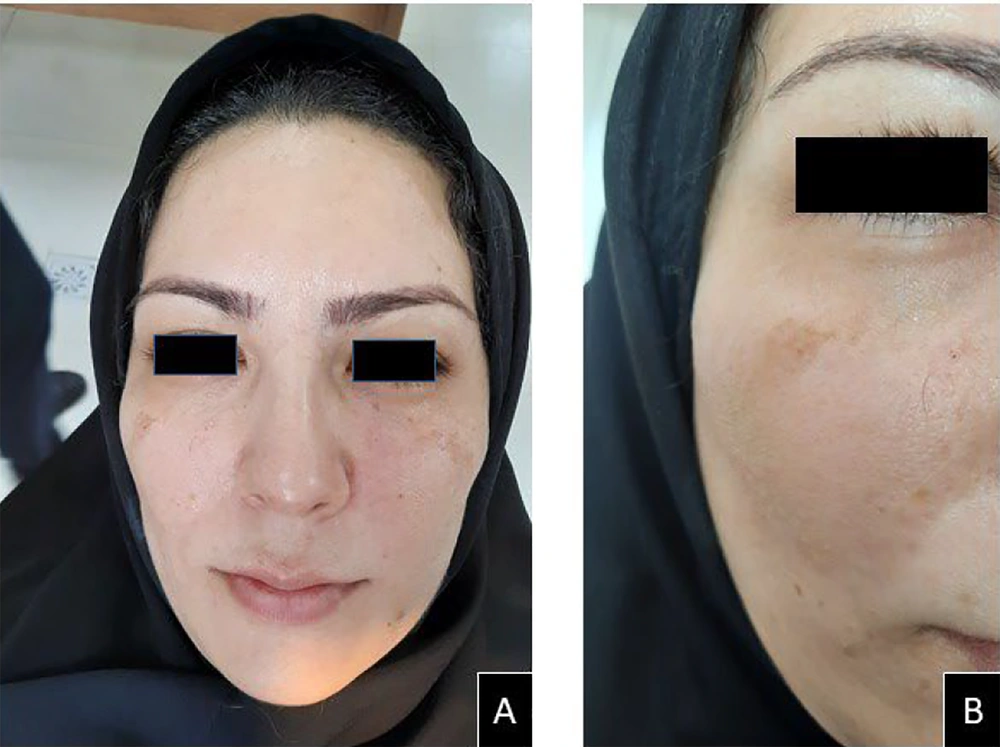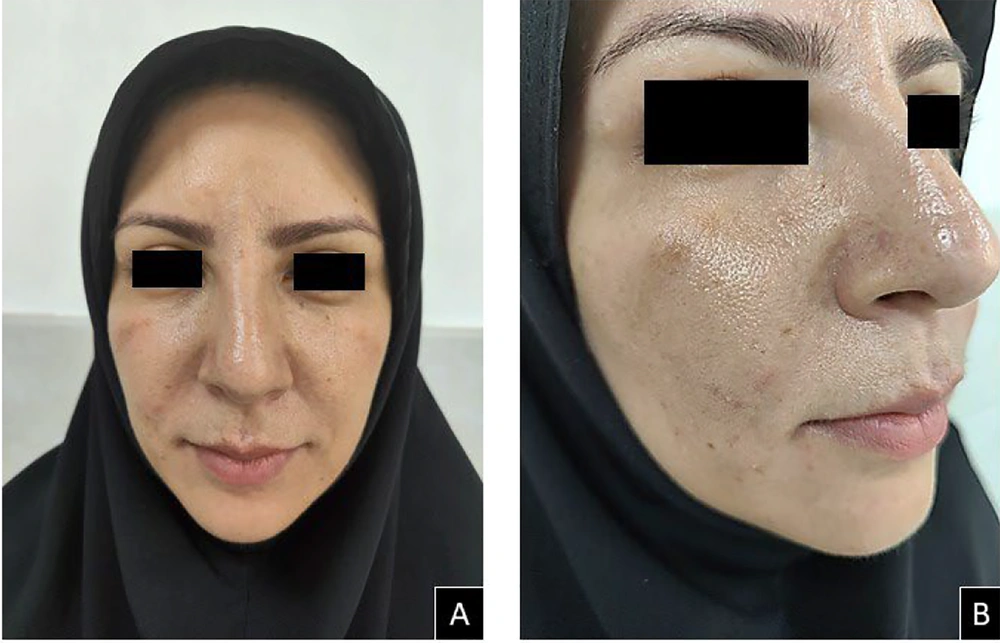1. Introduction
Pigmentation disorders, including common skin diseases, occur due to disturbances in the distribution, structure, and function of melanocytes. Pigmentation disorders can manifest in two forms: An increase or a decrease in skin pigmentation (1).
These pigmentation disorders pose challenges in terms of beauty, cognition, and psychological well-being for the patients, resulting in negative social and psychological effects. According to conducted studies, 23.6% of patients have experienced a decline in their social activities due to the impact of the disease. This finding highlights the necessity of evaluating and providing effective treatment for them (2, 3).
Microneedling is a safe and non-invasive dermatological treatment that can effectively address a range of skin concerns. This technique involves the use of sterile micro-needles to create small punctures in the skin, which stimulates the production of collagen and elastin. These two proteins are essential for maintaining the skin's youthful appearance, including firmness, smoothness, and radiance.
As we age, our skin might develop acne scars, blemishes, fine lines, wrinkles, and sagging due to various reasons. Microneedling can help improve these issues by promoting collagen and elastin production. Moreover, the treatment can enhance skin texture and transparency, making it a suitable solution for various skin problems. Microneedling also facilitates the absorption of skincare products, such as creams, serums, and gels. The micro-punctures created by the treatment allow for deeper penetration of these products into the skin, providing better results than surface application (4, 5).
Platelet-rich plasma (PRP) is one of the most common substances used in tissue regeneration. Platelet-rich plasma is essentially a suspension containing concentrated autologous platelets in plasma. Platelets are reservoirs filled with growth factors, such as PDGF and TGFβ1, 2. Platelets can be concentrated through centrifugation (6, 7). When PRP is combined with calcium chloride and thrombin, the cytokines present in the platelets are released. Platelet-rich plasma gel also has a high concentration of fibrinogen, which allows for blood clotting. Soft tissue healing is accelerated by the use of PRP due to increased collagen content, angiogenesis, and initial wound resistance. The growth factors present in PRP control essential cellular processes, such as chemotaxis, cellular differentiation, and metabolism (8).
Reduced cell count due to decreased blood flow or inadequate growth factors can be supplemented by platelet injection. Injecting PRP aims to minimize tissue damage and enhance healing mechanisms, such as chemotaxis, cell proliferation, angiogenesis, and extracellular matrix deposition. Platelet release of mitogenic and inflammatory substances plays a crucial role in tissue healing. Microneedling with PRP has proven effective in treating facial pigmentation, including melasma, hyperpigmentation, and post-inflammatory pigmentation (9, 10).
A comparative study by Chawla examined microneedling with PRP versus microneedling with vitamin C for treating atrophic acne scars. The study included 30 patients with such scars on their faces. One side of the face was treated with four sessions of microneedling with PRP; however, the other side received microneedling with vitamin C. The treatment sessions were spaced one month apart, and 27 out of the 30 patients completed the treatment. A higher number of patients reported a superior response to microneedling with PRP, compared to vitamin C. Patients expressed greater satisfaction with PRP treatment than with vitamin C (11).
Zhang et al. reviewed studies on PRP in dermatology, categorizing them into facial rejuvenation, hair, scars, vitiligo, and synergistic effects with CO2 fractional laser. The review showed significant advancements but insufficient evidence for general clinical use due to the lack of randomized controlled trials (RCTs) and sample limitations. More RCTs with adequate sample sizes are recommended for more convincing results (12).
Gawdat et al. studied the efficacy of microneedling with radiofrequency fractional alone and with PRP in neck rejuvenation on 20 patients with mild to moderate neck laxity. Both groups showed significant improvement in all parameters; nevertheless, the difference in average skin thickness after treatment between the two groups was statistically insignificant despite being higher in the PRP group (13).
El-Domyati et al. evaluated and compared microneedling to PRP or TCA peel for facial rejuvenation in 24 volunteers with photoaging. The participants were divided into three groups: Microneedling alone, microneedling with PRP, and microneedling with TCA 15% peel. The participants received six treatment sessions every 2 weeks. Photography and punch biopsies were taken before and 3 months after the treatment. Microneedling combined with PRP or TCA showed significant improvement, compared to microneedling alone, with a noticeable increase in epidermal thickness. Microneedling with PRP resulted in greater improvement in skin structures than microneedling with TCA (14).
Bandral et al. assessed the effectiveness and side effects of microneedling using a dermapen for treating facial scars in 50 eligible patients. After the procedure, three evaluators compared clinical photographs taken before and after the microneedling. Out of the total patients, 14%, 52%, 28%, and 6% had an excellent, a good, a moderate, and a poor response, respectively. The study concluded that microneedling with the dermapen is a simple and effective dermatological treatment (4).
Abdel-Motaleb et al. compared microneedling with PRP to microneedling alone in treating striae distensae (SD) in 40 patients. The group receiving microneedling with PRP showed better improvement in cutaneous lesions, increased collagen and elastic fiber deposition, enhanced proliferative activity in the epidermis, and reduced expression of caspase-3 protein, compared to microneedling alone. The aforementioned study concluded that combining microneedling with PRP is more effective for treating cutaneous lesions than microneedling alone (15).
Muhammad et al. compared the effectiveness of PRP alone to PRP combined with microneedling in patients with androgenetic alopecia. The study included 60 patients at a military hospital in Pakistan-UAE in 2020. After the intervention, the group receiving PRP combined with microneedling showed more negative hair pull test results and improved perception of hair loss, compared to the group receiving PRP alone (16).
2. Case Presentation
A 43-year-old female patient was referred to the Maxillofacial Surgery department of Zahedan University in Iran in November 2022 with a primary complaint of bilateral extensive facial pigmentation. According to the patient report, the pigmentation started 11 years ago (Figure 1). The patient denied having any systemic or allergic diseases. Considering the lack of effectiveness of previous treatments, such as tranexamic acid injections and empty microneedling, and taking into account the patient's prior familiarity with PRP and its intensity of impact, the decision was made to use microneedling combined with PRP to address facial pigmentation. The necessary explanations regarding the treatment plan were provided to the patient, and her consent was obtained for this type of treatment.
The production of PRP is a relatively easy process and only requires a patient blood sample and a centrifuge machine. To prepare the PRP, blood samples were first collected from the patient and placed in 10-milliliter tubes, along with an anticoagulant. The tubes containing the patient's blood were then centrifuged at a speed of 4 000 revolutions per minute for 15 minutes. The tubes were arranged in pairs in the centrifuge. After the centrifugation process was completed, three distinct parts were visible in the tube. Red blood cells settled at the bottom of the tube, the fibrin clot representing the PRP matrix was located in the middle of the tube, and the remaining plasma was found at the top.
The PRP matrix was obtained by extracting the middle layer from the tube using a syringe. A quarter of an hour before the procedure, local anesthesia was administered to the patients using a 2% lidocaine infiltrate injection, and a sterile alcohol pad was used at the site of intervention. In the first step, clinical photographs were taken of the area where the intervention was to be performed. Then, microneedling was carried out on the patient using a Dr. Pen A6 device with 12-millimeter cartridges. The speed of the microneedling device was set to 100 hertz, and the needle penetration depth into the tissue was initially set at half a millimeter and gradually increased to induce pinpoint bleeding on the skin. The device was used perpendicular to the skin, and any pinpoint bleeding that occurred during the process was cleaned with sterile gauze. Clinical photographs were then taken at the site of the intervention.
Overall, the patient underwent a total of 6 sessions of microneedling with PRP, with a time interval of 4 weeks between each session. Three months after the last session, the patient was re-evaluated, and photographs were taken for analysis. The intervention site was assessed by three independent evaluators, who compared the clinical photos before the procedure, immediately after the procedure, and 3 months after the procedure (Figure 2). All three evaluators confirmed complete pigmentation reduction and improvement in the patient's appearance.
3. Conclusions
Microneedling combined with PRP has emerged as a promising treatment for various dermatological conditions, including facial pigmentation. This combination method involves puncturing the skin with fine needles to create microchannels and then applying PRP onto the treated area. Platelet-rich plasma contains various growth factors and cytokines that promote collagen synthesis and stimulate tissue regeneration, improving skin texture and reducing pigmentation (5).
This combination therapy offers several advantages, such as minimal downtime, low risk of adverse effects, and potential long-lasting results. However, individual results might vary, and multiple treatment sessions might be required to achieve optimal outcomes. It is essential to consult with a qualified dermatologist or aesthetic professional to determine if microneedling with PRP is suitable for addressing specific facial pigmentation concerns (14).
It is important to note that individual responses might vary, and multiple treatment sessions might be necessary to achieve optimal outcomes. Therefore, it is crucial to consult with a qualified dermatologist or aesthetic professional to determine the suitability of microneedling with PRP for addressing specific pigmentation concerns. In the pursuit of achieving radiant and blemish-free skin, the combination of microneedling with PRP therapy emerges as a promising and effective solution for pigmentation reduction. Overall, microneedling with PRP holds great promise as a non-invasive and effective approach for revitalizing the skin and reducing pigmentation, offering individuals an opportunity to achieve a more even and rejuvenated complexion. This therapy presents a valuable option for individuals seeking to address pigmentation issues while simultaneously improving overall skin health. Its ability to promote collagen production, minimize downtime, and offer long-lasting results makes it a compelling choice in the field of aesthetic dermatology. Further research and clinical trials are still needed to explore the optimal treatment protocols, long-term efficacy, and potential combination therapies for enhancing the outcomes of microneedling with PRP in pigmentation reduction (17, 18).


